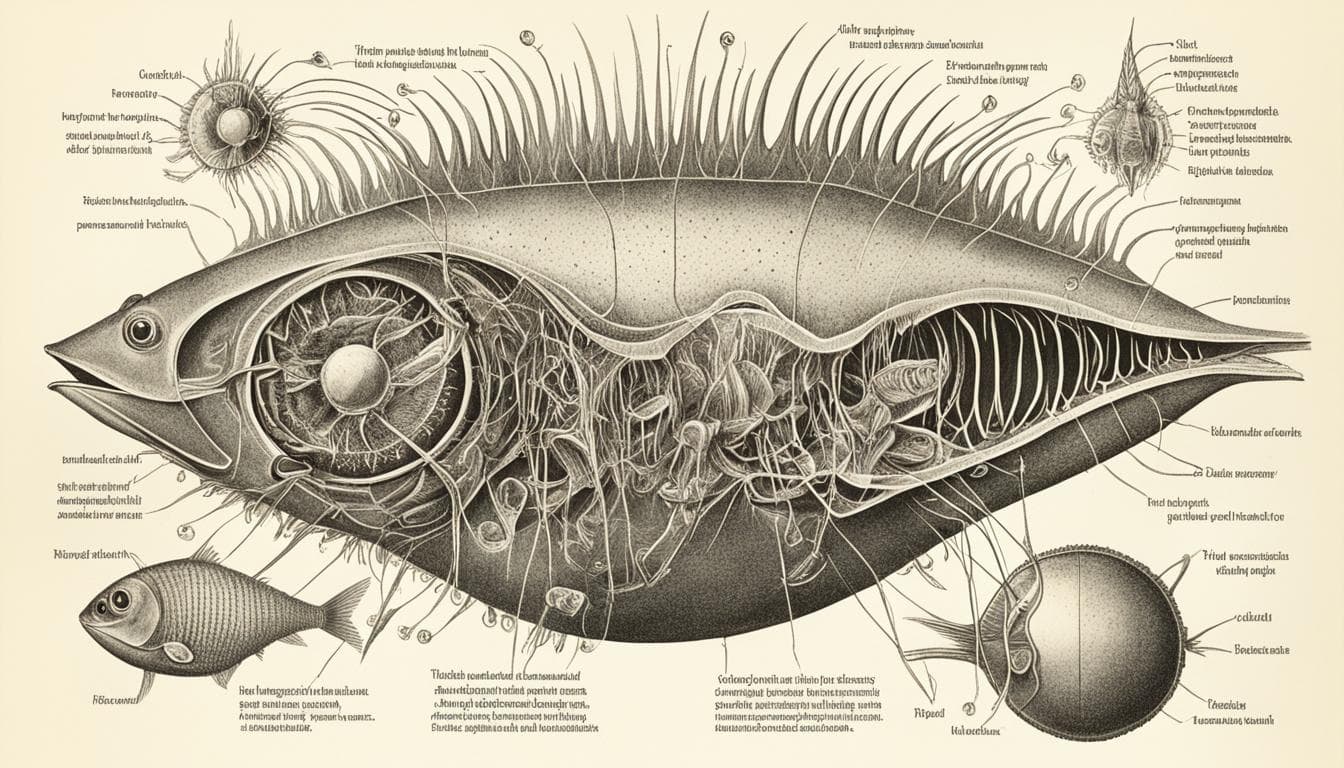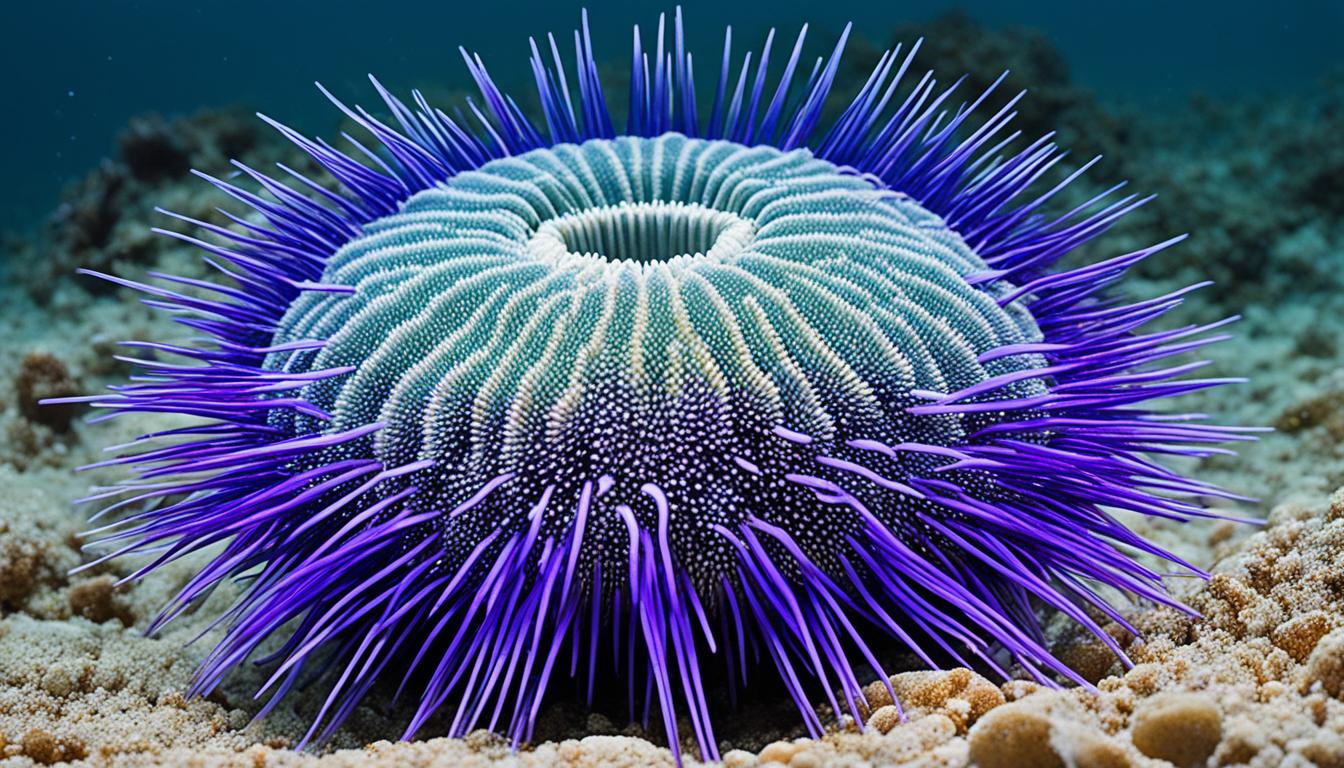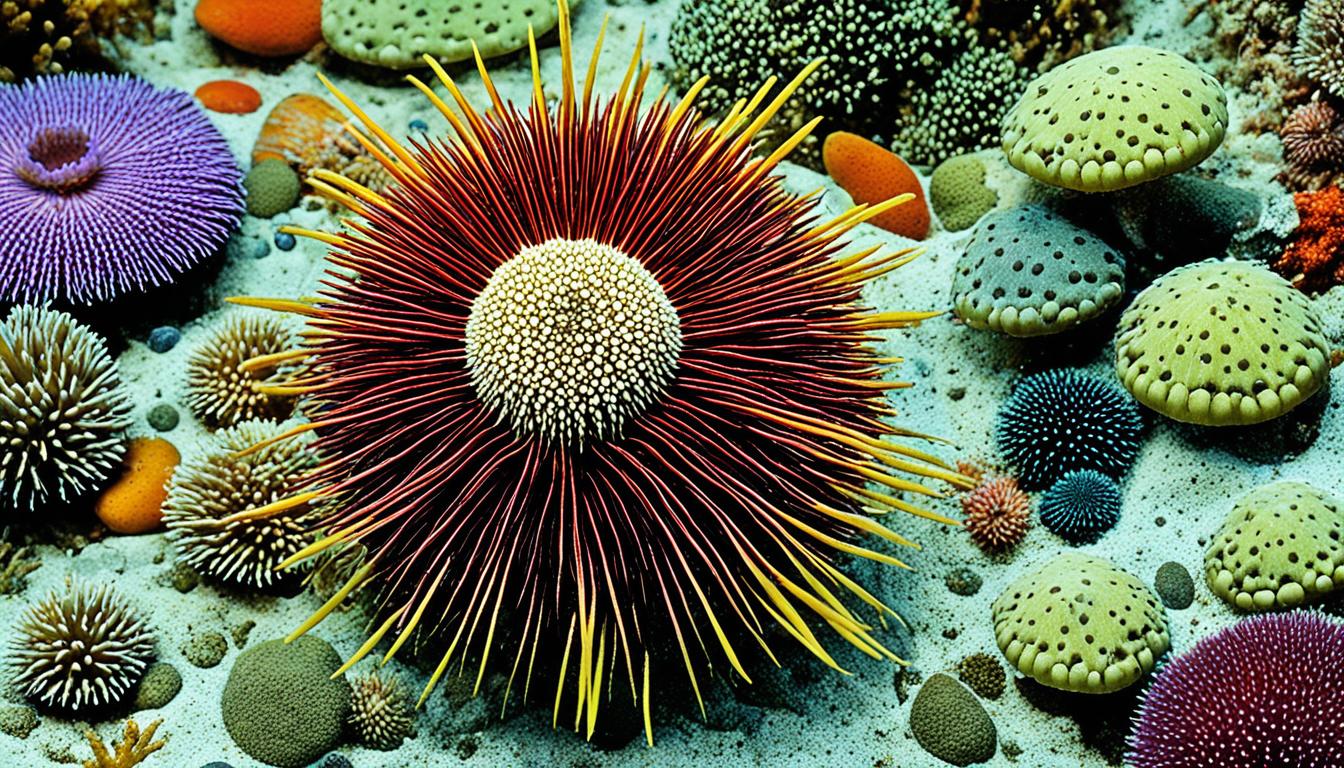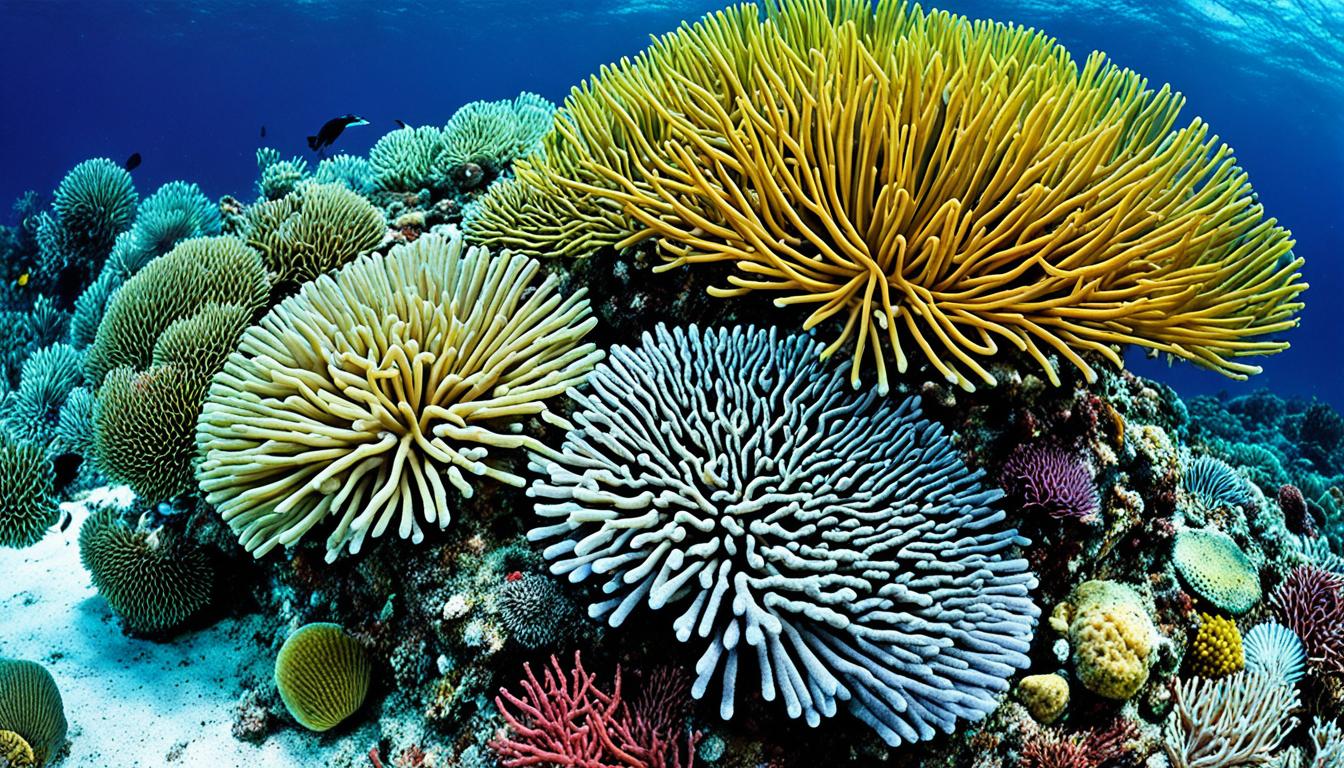Anglerfish reproduction is a fascinating topic that shows how they adapt to life in the deep sea. You might ask, how do anglerfish reproduce? In the Ceratioidei suborder, males are much smaller than females. This size difference leads to males losing their hunting skills. They depend on females for food.
Looking into the anglerfish reproductive system helps us understand their mating habits. These include the unique way males form parasitic relationships with females.
Understanding Anglerfish Reproduction
The anglerfish reproduction process is unique, ensuring survival in deep-sea environments. Males and females have special adaptations, especially in the Ceratioidei family. These adaptations make anglerfish reproduction fascinating.
The Unique Reproductive System of Anglerfish
Anglerfish have a special reproductive system. They use sexual parasitism, where males attach to females. This bond is permanent, allowing males to get nutrients from the female and ensuring they can reproduce.
They have strong bites that keep them attached to the female’s body. This unique system helps them survive in deep-sea environments.
Importance of Ceratioidei in Anglerfish Reproduction
The Ceratioidei family is key to understanding anglerfish reproduction. Their mating strategies help them survive in places where finding a mate is hard. These strategies show how anglerfish reproduction is crucial for their survival and diversity.
| Adaptation | Description | Reproductive Benefit |
|---|---|---|
| Permanent Attachment | Males attach to females via a strong bite. | Ensures constant access to the female for mating. |
| Nutrient Transfer | Males derive sustenance from females. | Increases chances of reproductive success. |
| Low Encounter Rates | Adapted to deep-sea habitats where finding mates is difficult. | Facilitates reproduction despite rare mating opportunities. |
How Do Anglerfish Reproduce?
Anglerfish have a unique way of reproducing that stands out in the ocean. Males have special mating habits that help them reproduce in the dark ocean depths. This process is part of their anglerfish reproductive system.
Parasitic Mating Habits of Male Anglerfish
Male anglerfish have a unique mating strategy. They find females by following pheromones in the water. Once they find a female, the male attaches to her body with his snout.
This bond is permanent. The male’s body changes, becoming dependent on the female for food. This shows how anglerfish have adapted to mate in such a way.
The Role of Pheromones in Mating
Pheromones are key in finding mates for anglerfish. Females send out chemical signals to draw in males. These signals help males find females in the dark ocean.
Once attached, the male gives sperm to the female when she is ready to lay eggs. This completes their reproductive cycle.
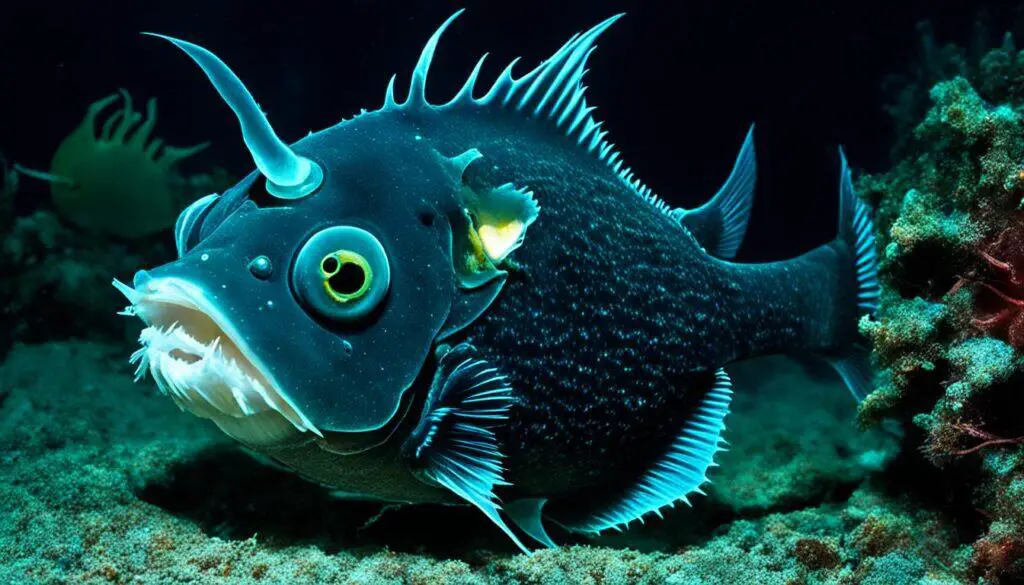
| Aspect | Description |
|---|---|
| Attachment | Male latches onto female, forming a permanent bond. |
| Nutritional Dependency | Male relies on female for nourishment as his body deteriorates. |
| Pheromonal Cues | Females release chemicals to attract males for reproduction. |
| Fertilization Timing | Male delivers sperm when female is ready to spawn. |
Anglerfish Mating Rituals and Behavior
Mating rituals of anglerfish are truly captivating. They use bioluminescent displays to attract mates. This shows how complex their mating habits are and the importance of visual signals in the deep sea.
Female Bioluminescent Lures and Their Attractiveness
Females have bioluminescent lures to draw in males. These bright signals shine through the dark waters, making them stand out. The lure’s brightness and movement help attract males and also help them compete with each other.
This bioluminescence is key to the anglerfish breeding cycle. It helps ensure successful mating.
Competition and Courtship Among Males
When females show their lures, males compete fiercely. They try to show they are the best mates by being close to the female. They display their strength and health to stand out.
This competition shows the unique mating habits of anglerfish. Only the best males get to mate in the vast ocean.
Insights into the Anglerfish Breeding Cycle
The breeding cycle of anglerfish is fascinating and deeply tied to seasonal changes. It shows how they reproduce and adapt to their environment. Spawning happens in warmer months, when conditions are best for it. Females release a gelatinous mass of eggs into the water, protecting the embryos from predators.
Seasonal Patterns of Spawning Behavior
Seasons play a big role in when anglerfish spawn. They do this when it’s warmer and food is plentiful. This shows how climate affects their reproduction. Knowing this helps scientists and those working to protect deep-sea life.
Eggs and Embryo Development in Anglerfish
The early stages of anglerfish embryos are key to their survival. Studies show that warmer water helps them grow faster and increases their chances of survival. Learning about their breeding cycle shows how important they are to their ecosystem.
FAQ
How do anglerfish reproduce?
Anglerfish reproduce in a unique way. Males, much smaller, attach to females in a parasitic relationship. They rely on the female for nutrition and supply sperm for fertilization when she’s ready to spawn.
What is the reproductive system of anglerfish?
The anglerfish reproductive system shows deep-sea adaptations. In the Ceratioidei suborder, males and females are very different. Males become parasitic, losing hunting adaptations.
What are some fascinating facts about anglerfish reproduction?
Anglerfish have unique mating habits. Males attach to females and use pheromones to find them. The female’s bioluminescent lure helps attract partners.
What are the mating habits of male anglerfish?
Male anglerfish use pheromones to find females and attach to them. This often leads to a permanent bond. The male benefits from the female’s nutrients and supplies sperm for fertilization.
How do bioluminescent lures aid in anglerfish mating?
The female anglerfish’s bioluminescent lure helps attract males in dark waters. It makes them more visible. This lure also helps males compete for a mate’s attention.
What does the anglerfish breeding cycle look like?
Anglerfish breed in warmer months, based on environmental conditions. Females release eggs in gelatinous masses to protect them. The temperature affects embryo development and growth rates.
How do anglerfish care for their embryos?
Anglerfish don’t provide traditional parental care. They release eggs in a gelatinous mass for protection. Temperature affects the embryos until they hatch.
What is sexual dimorphism in anglerfish?
Sexual dimorphism in anglerfish means size differences between males and females. Males are much smaller and live parasitically. Females are larger and don’t need the same hunting adaptations.

